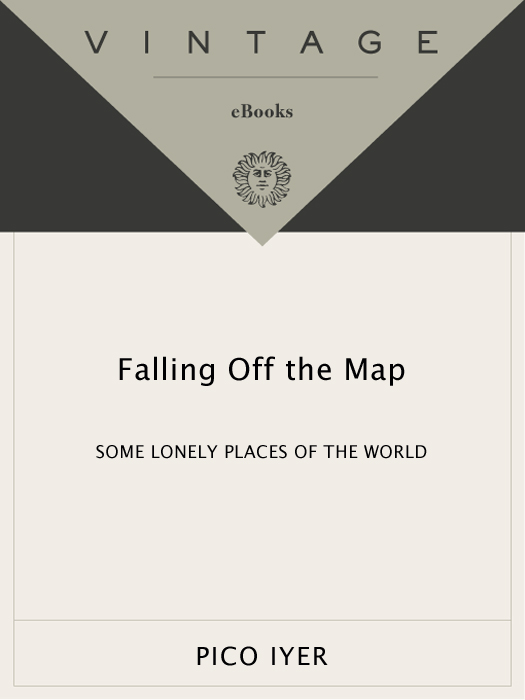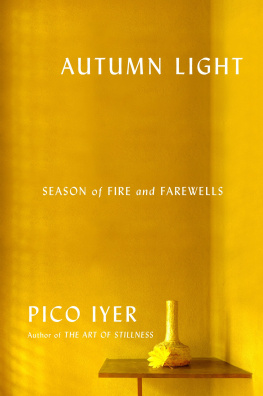Pico Iyer - Falling Off the Map: Some Lonely Places of the World
Here you can read online Pico Iyer - Falling Off the Map: Some Lonely Places of the World full text of the book (entire story) in english for free. Download pdf and epub, get meaning, cover and reviews about this ebook. year: 2011, publisher: Vintage, genre: Art. Description of the work, (preface) as well as reviews are available. Best literature library LitArk.com created for fans of good reading and offers a wide selection of genres:
Romance novel
Science fiction
Adventure
Detective
Science
History
Home and family
Prose
Art
Politics
Computer
Non-fiction
Religion
Business
Children
Humor
Choose a favorite category and find really read worthwhile books. Enjoy immersion in the world of imagination, feel the emotions of the characters or learn something new for yourself, make an fascinating discovery.

Falling Off the Map: Some Lonely Places of the World: summary, description and annotation
We offer to read an annotation, description, summary or preface (depends on what the author of the book "Falling Off the Map: Some Lonely Places of the World" wrote himself). If you haven't found the necessary information about the book — write in the comments, we will try to find it.
Pico Iyer: author's other books
Who wrote Falling Off the Map: Some Lonely Places of the World? Find out the surname, the name of the author of the book and a list of all author's works by series.
Falling Off the Map: Some Lonely Places of the World — read online for free the complete book (whole text) full work
Below is the text of the book, divided by pages. System saving the place of the last page read, allows you to conveniently read the book "Falling Off the Map: Some Lonely Places of the World" online for free, without having to search again every time where you left off. Put a bookmark, and you can go to the page where you finished reading at any time.
Font size:
Interval:
Bookmark:

Pico Iyers
Falling Off the Map
Intriguing Iyers eye for detail offers some nice glimpses of destinations few will achieve.
Washington Post Book World
Pungent Iyer has a remarkable eye for the gently absurd details that lift the lid off a place. I wouldnt trade his little gem[s] of information for all the guidebooks, Baedekers and travel fact-sheets in the world.
Boston Sunday Globe
[Iyer is] among the best of the current practitioners of literary travel writing. The reader very quickly comes to trust Iyers judgments. Having [him] as a tour guide, its hard not to want to fall in with him; his lonely places breed zany characters, bizarre events. But what really makes the journey delightful is Iyers way with words.
Los Angeles Daily News
Marvelous memorable. Always a keen eye, Iyer is at his best when hes swept away by some aspect of a particular destination. [He] seems to hit upon the gist of why lonely places are so fascinating. Iyers book is a celebration of places that arent inclined to purge their own peculiarities to accommodate the expectations of the rest of the world.
Wall Street Journal
A classic travel book in the old sense, not having anything to do with the questionable habits of tourism. Iyer is pungent, witty, often brilliant on his far-flung destinations.
Jim Harrison
Vivid Iyer remains a consistently engaging observer. The Australian Outback and other landscapes spur Iyers eloquence. Irony meets elegy in [his] most haunting reports.
Cleveland Plain Dealer
Iyer brings a contemplative quality to his work that makes it exceptional a wonderful companion.
Boston Globe
Iyer is a post-modern tourist, drawn to the textures of the present. He is alive to video culture and what he terms the emergent global single polyglot multiculture. His whimsy makes him a more effective social critic than any ideologue. Iyers singular outlook and powers of observation do not grow stale.
Christian Science Monitor
[Iyer has] a special genius for spotting the loony-tunes aspects of East-West culture collisions. This is terrific stuff.
Seattle Times
A vivid look at places long lost to mainstream travelers.
Travel Holiday
Pico Iyer is a matchless travel companionwherever it is he wishes us to accompany him an excellent introduction to one of the most perceptive and engaging travel writers of his generation Pico Iyer displays here that love and understanding of differing peoples and temperaments that finally distinguishes the brilliant observer. Even if he did fall off the map, Id happily go along for the ride.
Toronto Star
Entrancing I enjoyed it more than any travel book Ive read in years.
Norman Lewis

Falling Off the Map
Pico Iyer was born in Oxford in 1957 and was educated at Eton, Oxford, and Harvard. He is an essayist for Time magazine and a contributing editor at Cond Nast Traveler. He is also the author of Video Night in Kathmandu and The Lady and the Monk.
Books by Pico Iyer
Falling Off the Map
The Lady and the Monk
Video Night in Kathmandu

 FIRST VINTAGE DEPARTURES EDITION, MAY 1994
FIRST VINTAGE DEPARTURES EDITION, MAY 1994
Copyright 1993 by Pico Iyer
All rights reserved under International and Pan-American Copyright Conventions. Published in the United States by Vintage Books, a division of Random House, Inc., New York, and simultaneously in Canada by Random House of Canada Limited, Toronto. Originally published in hardcover by Alfred A. Knopf, Inc., New York, and Jonathan Cape Ltd., London, in 1993.
Parts of these chapters appeared, in somewhat different form, in Cond Nast Traveler and The New Republic. Cuba: An Elegiac Carnival was originally published in Islands.
Library of Congress Cataloging-in-Publication Data Iyer, Pico.
Falling off the map: some lonely places of the world / Pico
Iyer.1st Vintage departures ed.
p. cm. (Vintage departures)
Originally published: New York: Knopf, 1993.
eISBN: 978-0-307-76072-2
1. Iyer. PicoJourneys. 2. Voyages and travels. I. Title.
[G465.194 1994]
910.4dc20 93-43494
Author photograph Mark Richards
v3.1
This round gold is but the image of the rounder globe, which, like a magicians glass, to each and every man in turn but mirrors back his own mysterious self.
MELVILLE
Most of these essays were originally written, in somewhat different form, to introduce potential visitors to places of potential interest; to serve, that is, as open-eyed first impressions. In many cases, circumstances have overtaken meArgentina has stabilized its peso, Cubas destiny changes with every passing month, parts of Vietnam are probably unrecognizable. Still, I have not tried to update the chapters, or to allow myself the luxury of retrospective wisdom and prescience. These pieces were aimed to catch their subjects at interesting historical moments, but in moods that would not change with historys tides.
I would like to extend sincerest thanks to the editors who dreamed up or supported most of the journeys herein described: Harold Evans, Thomas Wallace, and colleagues at Cond Nast Traveler; Joan Tapper at Islands; Andrew Sullivan at The New Republic; and Henry Muller and friends at Time. Thank you, too, to the brothers at the Immaculate Heart Hermitage in Big Sur, for offering peace beyond measure and the perfect place in which to think about loneliness and space.
On every trip I took to Havana, the ritual was the same: I would get into a car with two of my friends (into a 56 De Soto most likely), and we would judder off towards Jos Mart International Airport. We drove past huge pictures of Che ( BE LIKE HIM ), past billboards that said SOCIALISM OR DEATH, THE MOTHERLAND BEFORE EVERYTHING, IT IS ALWAYS THE 26TH (of July, 1953), past long lines of women waiting for a bus. We spoke only in indefinite pronouns, so as not to arouse the drivers suspicions, pretending that we thought that everything was well, pretending that we did not hope to meet again. When we arrived at the airport, we would get out and sit under a tree just outside the battered terminal. There my friends would tell me about everything they planned to do as soon as they arrived in America: how they would open a bookstore, or take pictures of the clubs on Forty-second Street, or send all the jeans they could find back to their families at home. Then, when it came time for me to leave, they would turn and, without looking back, walk across the street to another tree and wait for a bus back into town. They couldnt bear, they said, to see me getting on the plane that they had been dreaming of for twenty-five, or twenty-seven, or thirty-one years.
That is one of the things that make me think of Cuba as a Lonely Place. Just like the old men sitting on the terraces of the cheap hotels, showing you photos of long-lost fiances (Miss Dade County 1956), or the trim government officials who ask, in perfect Eisenhower-era English, Do they still play tetherball in the States? Just like the statues of Don Quixote set on lonely hills across the countryside, and the pictures of Ava Gardner in the downtown restaurants; just like the tiny huddle of worshipers singing hymns on Easter Sunday, or the messages people give you to take to unheard-from mothers in the Bronx, distant cousins in Miami, an Indianof course you can find himby the name of Singh. Cuba is ninety miles from the United States, but it might as well be a universe away. Letters pass only infrequently between the two neighbors, and telephone calls are next to impossible (though it was once my mixed fortune to befriend, of all things, a telephone operator: every night in Havana, she would call me up, unbidden, and serenade me with Spanish love songs, and for months after I returned home, the phone would ring, at 2:00 a.m., 3:15 a.m., 4:36 a.m., and I would pick it up, to hear
Font size:
Interval:
Bookmark:
Similar books «Falling Off the Map: Some Lonely Places of the World»
Look at similar books to Falling Off the Map: Some Lonely Places of the World. We have selected literature similar in name and meaning in the hope of providing readers with more options to find new, interesting, not yet read works.
Discussion, reviews of the book Falling Off the Map: Some Lonely Places of the World and just readers' own opinions. Leave your comments, write what you think about the work, its meaning or the main characters. Specify what exactly you liked and what you didn't like, and why you think so.







